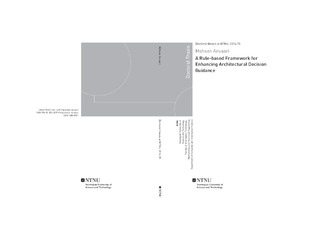| dc.contributor.advisor | Conradi, Reidar | |
| dc.contributor.advisor | Jaccheri, Letizia | |
| dc.contributor.advisor | Sørensen, Carl-Fredrik | |
| dc.contributor.author | Anvaari, Mohsen | |
| dc.date.accessioned | 2016-06-02T11:08:16Z | |
| dc.date.available | 2016-06-02T11:08:16Z | |
| dc.date.issued | 2016 | |
| dc.identifier.isbn | 978-82-326-1479-0 | |
| dc.identifier.issn | 1503-8181 | |
| dc.identifier.uri | http://hdl.handle.net/11250/2391197 | |
| dc.description.abstract | Architectural decision-making is a non-trivial process for architects in software development
projects. In many cases, such a process starts by identifying architectural issues that
an architect should make decisions about. In the second step, the architects explore available
alternatives to solve the architectural issues. In the final step, the architects choose
one of the candidate alternatives for each issue, based on the decision drivers. Notable
progress has been made to assist practitioners in choosing one alternative among the possible
alternatives. Several methods and tools have been developed for documenting the
rationale and the outcome of the decision-making process. There is, nevertheless, little
research focusing on identifying architectural issues that are eligible for a particular
project. In the absence of systematic methods of identifying architectural issues, practitioners
mainly start their architectural decision-making process based on intuition and
prior experience, which may be insufficient due to cognitive biases.
We have investigated the industrial context to understand the attitudes and challenges
of large-scale enterprises in making and reusing architectural decisions. Then, we have
reviewed the literature to identify the gap in developing architectural knowledge about
the past into architectural decision guidance for the future. Afterwards, we have tackled
the problem of enhancing architectural guidance by developing a framework called Semi
Automated Design Guidance Enhancer (SADGE). SADGE extracts architectural issues
from project documents and domain literature by applying natural language processing
(NLP). This encourages practitioners to identify more architectural issues in the early
phases of their projects, making them more prepared for the later phases, when changing
and/or refactoring the architecture is more costly.
Finally, we have evaluated the framework by conducting a case study on project documents
and running experiments with IT students and expert IT architects. The results
of the evaluation show that SADGE extracts architectural issues with a significant recall
while reducing the manual knowledge processing effort notably. The evaluation also reveals
that the experts believe that the framework can be very helpful for them to either
reduce the amount of text to read, or to identify hot spots in their documents that need
extra attention.
The main contributions of this thesis are:
C1 An overview of the state-of-the-art and state-of-the-practice in making and reusing
architectural decisions.
C2 A rule-based framework for developing architectural knowledge in project documents
and domain literature into architectural decision guidance.
C3 Results of empirical evaluation of developing architectural decision guidance by
employing a rule-based framework. | nb_NO |
| dc.language.iso | eng | nb_NO |
| dc.publisher | NTNU | nb_NO |
| dc.relation.ispartofseries | Doctoral thesis at NTNU;2016:70 | |
| dc.relation.haspart | Paper 1:
Anvaari, Mohsen; Conradi, Reidar; Jaccheri, Maria Letizia.
Architectural Decision-Making in Enterprises: Preliminary Findings from an Exploratory Study in Norwegian Electricity Industry. Lecture Notes in Computer Science 2013 ;Volum 7957 -
The final publication is available at Springer via
<a href="http://dx.doi.org/10.1007/978-3-642-39031-9" target="_blank"> http://dx.doi.org/10.1007/978-3-642-39031-9</a> | |
| dc.relation.haspart | Paper 2:
Anvaari, Mohsen; Zimmermann, Olaf.
Towards Reusing Architectural Knowledge as Design Guides: Functional Requirements, Tool Analysis and Research Roadmap. Proceedings of the International Conference on Software Engineering and Knowledge Engineering 2014 | |
| dc.relation.haspart | Paper 3:
Anvaari, Mohsen; Zimmermann, Olaf.
Semi-automated design guidance enhancer (SADGE): A framework for architectural guidance development. Lecture Notes in Computer Science 2014 ;Volum 8627
LNCS. s. 41-49 -
The final publication is available at Springer via
<a href="http://dx.doi.org/10.1007/978-3-319-09970-5_4" target="_blank">
http://dx.doi.org/10.1007/978-3-319-09970-5_4</a> | |
| dc.relation.haspart | Paper 4:
Anvaari, Mohsen; Zimmermann.; Olaf.; Sørensen, Carl-Fredrik
Rule-based Extraction of Architectural Issues from
Software Architecture Documents - Is not included due to copyright | |
| dc.relation.haspart | Paper 5:
Anvaari, Mohsen; Sørensen, Carl-Fredrik ; Zimmermann.; Olaf.
Associating Architectural Issues with Quality Attributes
A Survey on Expert Agreement - Is not included due to copyright | |
| dc.title | A Rule-based Framework for Enhancing Architectural Decision Guidance | nb_NO |
| dc.type | Doctoral thesis | nb_NO |
| dc.subject.nsi | VDP::Technology: 500::Information and communication technology: 550::Computer technology: 551 | nb_NO |

